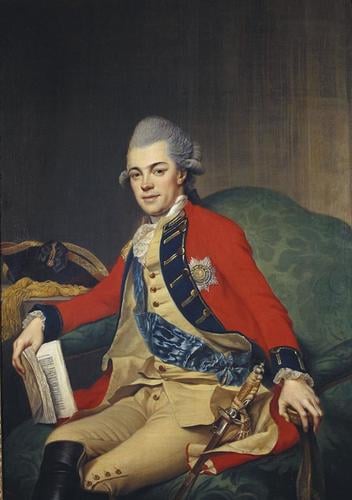Carl Ludwig Friedrich (1741-1816), Duke of Mecklenburg-Strelitz, later Carl II, Grand Duke of Mecklenburg-Strelitz Signed and dated 1770
Oil on canvas | 144.6 x 102.5 cm (support, canvas/panel/stretcher external) | RCIN 402463
-
Born in Copenhagen in 1716, Johann Georg Ziesenis was a pupil of his father Johan Jürgen Ziesenis. He became a German citizen in 1743 and was first appointed court painter in Zweibrücken, then in Mannheim. In 1760 he entered into the service of George II of Hannover and, subsequently, George III; Ziesenis also worked in Berlin and Brunswick. The Royal Collection owns a significant amount of Ziesenis portraits, illustrating members of various eighteenth-century noble German dynasties – notably from the houses of Mecklenburg-Streliz and Brunswick-Wolfenbüttel.
Producing around 260 works in his lifetime, most of which were portraits, Ziesenis is remembered for his intimate portrayals of the future wife of George III, Charlotte of Mecklenburg-Streliz, Crown Prince Frederick and Frederick II. He began his career working in a traditional baroque style but, inspired by Rubens and Van Dyck, effected a transformation in the 1750s, introducing a heightened psychology to his character studies. Ziesenis practised a new type of enlightened portraiture, the private court portrait. He depicted his subjects at ease in natural surroundings, an emphasis on education and worldliness rather than on power. In this way Ziesenis' work ranks alongside the great English eighteenth-century portraitists. Indeed, his biographer, F. F. Kuntze, states that in invention and execution Ziesenis was the highpoint of eighteenth-century German portraiture and his best work ranks alongside the great painters of the English enlightenment.
In the later part of his career, Ziesenis' art exemplified the period of Zopfstil or Citizen's Rococo, literally a "pig-tail style" coined after Louis XVI and the waning Ancien Regime. This new style stood at a transition point between late Rococo and the burgeoning reprisal of stark, Hellenic Classicism in the hands of Winckelmann, best displayed in the furniture of the time. Ziesenis' portraits of this period introduce a certain air of civic responsibility and mark a departure from the florid pleasure gardens of Rococo fashion.
Queen's Charlotte's brother, Charles II, succeeded his elder brother as ruler of the duchy of Mecklenburg-Strelitz in 1794; assuming the rank of Grand Duke in 1815. He had previously served as Governor of Hanover from 1776 to 1786. In 1768 Charles married Princess Friederike of Hesse-Darmstadt, with whom he had ten children. An enlightened ruler, Charles introduced agricultural reforms, a new police force, and made education compulsory for the first time. The sitter is here shown three-quarter-length, wearing a red uniform with blue facings and cuffs and a blue ribbon & star; his bicorne hat rests on a marble table top.
The painting appears in Pyne's illustrated 'Royal Residences' of 1819, hanging in the Dining Room at Windsor Castle (RCIN 922119).
Signed and dated: J.G.Ziesenis / pin. a Hanover / 1770Provenance
Probably acquired by Queen Charlotte; first recorded in 1819 at Frogmore House, with its pair (RCIN 402466), a portrait of the sitter's wife.
-
Medium and techniques
Oil on canvas
Measurements
144.6 x 102.5 cm (support, canvas/panel/stretcher external)
164.5 x 122.3 x 6.1 cm (frame, external)
Category
Object type(s)
Alternative title(s)
Charles II, Grand Duke of Mecklenburg-Strelitz (1741-1816)
Carl II, Grand Duke of Mecklenburg-Strelitz (1741-1816)








